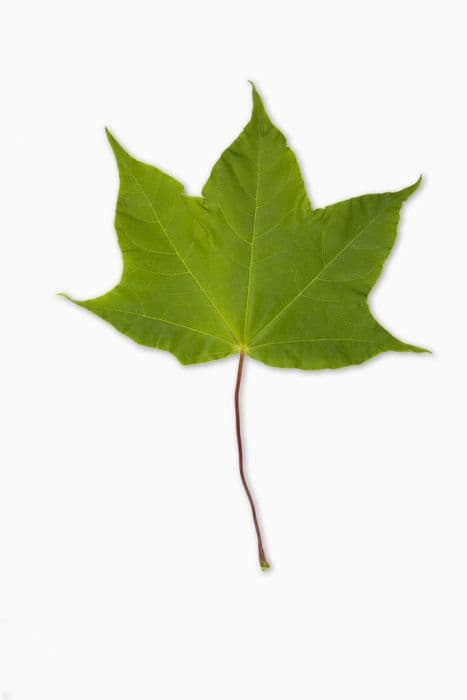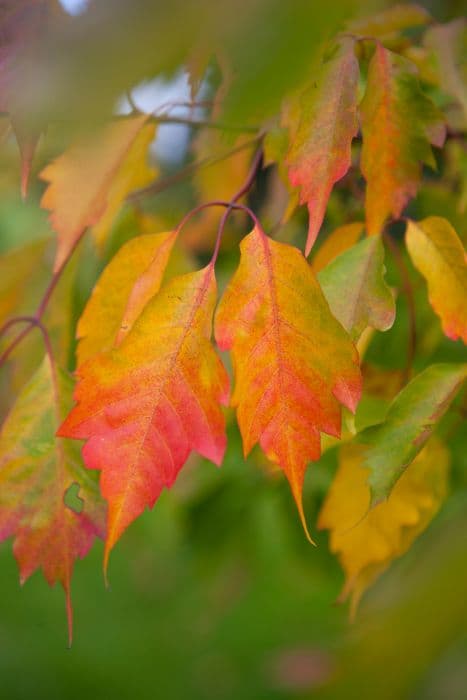Japanese Maple Acer palmatum 'Villa Taranto' (L)

ABOUT
The 'Villa Taranto' Japanese maple is a captivating ornamental tree renowned for its elegant leaf shape and spectacular color transitions throughout the seasons. This variety presents a delicate leaf form that is deeply cut, somewhat resembling the fingers of an outstretched hand or the fine structure of a fern. Each leaf, with typically five to seven lobes, emerges with a bright and vibrant green color. As the seasons change, the foliage undergoes a stunning transformation. During the autumn months, the leaves take on a breathtaking display of colors, ranging from vivid oranges to fiery reds, providing a striking visual contrast against the landscape. The tree's branching structure adds to its ornamental appeal, often forming a graceful, rounded canopy that offers dappled shade below. The bark of the tree is another subtle yet attractive feature, with a smooth texture and a color that may range from shades of gray to a soft green, providing visual interest even in the dormant winter months when the leaves have fallen. Overall, the 'Villa Taranto' Japanese maple's beauty lies in its exquisite foliage and the enchanting color show it provides throughout the year.
About this plant
 Names
NamesFamily
Sapindaceae
Synonyms
Japanese Maple, Smooth Japanese Maple
Common names
Acer palmatum 'Villa Taranto'
 Toxicity
ToxicityTo humans
Japanese maple, specifically the 'Villa Taranto' cultivar, is generally considered to be non-toxic to humans. There is no widespread evidence or recorded cases of poisoning from ingesting parts of this plant. As is the case with any plant material, individuals could potentially have an allergic reaction or experience gastrointestinal discomfort if ingested, but this is not common and Japanese maple is not known for being a poisonous plant.
To pets
Japanese maple, which includes the 'Villa Taranto' variety, is not listed as toxic to pets such as dogs and cats. While it is always best to prevent pets from consuming plant material to avoid potential digestive issues or unforeseen allergic reactions, there are no specific symptoms of poisoning associated with this plant because it is not considered poisonous. As with any non-food item, if a pet ingests substantial amounts of the plant, it may experience mild stomach upset simply due to the ingestion of non-digestible matter.
 Characteristics
CharacteristicsLife cycle
Perennials
Foliage type
Deciduous
Color of leaves
Varies
Height
6-10 feet [1.8-3 meters]
Spread
6-10 feet [1.8-3 meters]
Plant type
Tree
Hardiness zones
5-9
Native area
Japan
Benefits
 General Benefits
General Benefits- Aesthetic Appeal: This Japanese Maple variety has a unique leaf shape and color that adds visual interest to any garden or landscape.
- Seasonal Color: 'Villa Taranto' displays a range of colors throughout the seasons, from spring blooms to vibrant fall foliage.
- Shade Provision: As a moderately growing tree, it provides shade in the garden, creating a cooler microclimate underneath its canopy.
- Wildlife Habitat: The plant can support local ecosystems by providing shelter and food sources for birds and beneficial insects.
- Soil Erosion Control: The root systems of 'Villa Taranto' help stabilize the soil and prevent erosion in the garden or landscape setting.
- Urban Tolerance: It is relatively tolerant to urban pollution, making it a suitable choice for city gardens and public landscaping.
- Space Efficiency: Its moderate size makes it suitable for smaller gardens or those with limited space, without sacrificing visual impact.
- Cultural Significance: Japanese Maples are often associated with peace and tranquility, and are frequently used in traditional Japanese garden design.
 Medical Properties
Medical PropertiesThis plant is not used for medical purposes.
 Air-purifying Qualities
Air-purifying QualitiesThis plant is not specifically known for air purifying qualities.
 Other Uses
Other Uses- Ink Production: The deep red sap of the Japanese maple can be processed to make natural inks for art and calligraphy.
- Leaf Castings: The distinctive leaves can be used to make detailed castings for decorative purposes or to create unique pieces of jewelry.
- Culinary Garnish: While not commonly consumed, the bright foliage can be used as an ornamental garnish for special dishes to add a pop of color.
- Photography: Japanese maple trees are often used as a stunning subject for photography, especially during fall when the leaves change color.
- Wood Turning: Japanese maple wood can be used for woodturning to create ornamental objects, due to its fine grain and aesthetic appeal.
- Bonsai: 'Villa Taranto' is a popular variety for the art of bonsai, where it is meticulously pruned and shaped to create miniature landscapes.
- Leaf Prints: The leaves can be used to create natural prints on fabric or paper by using them as stamps with paint or ink.
- Feng Shui: Planted in the garden, it is believed to bring positive energy according to the principles of Feng Shui.
- Craft Material: The branches and leaves can be used in craft projects, such as making wreaths or as part of floral arrangements.
- Artistic Inspiration: Many artists use the beautiful form and colors of the 'Villa Taranto' Japanese maple as inspiration for paintings, drawings, and sculptures.
Interesting Facts
 Feng Shui
Feng ShuiJapanese Maple, in Feng Shui, is believed to bring calm and balance when placed in a garden, especially in the East for family health or Southeast for wealth and abundance due to its lush foliage and elegant growth.
 Zodiac Sign Compitability
Zodiac Sign CompitabilityThe Japanese Maple is not used in astrology practice.
 Plant Symbolism
Plant Symbolism- Beauty: The intricate and delicate form of the Japanese Maple's leaves represent beauty and artistic elegance.
- Calm: The tranquil growth pattern and the serene appearance of the Japanese Maple symbolize a sense of calm and peacefulness.
- Change: With leaves that change color through the seasons, the Japanese Maple is a symbol of the changing nature of life and the embracing of new phases.
- Endurance: As a plant that can survive cold winters, the Japanese Maple represents endurance and the ability to withstand challenges.
- Balance: The symmetrical shape and balanced branching of the Japanese Maple symbolize harmony and equilibrium in life.
 Water
WaterThe Japanese Maple needs consistent moisture but should not be waterlogged. During the growing season, water the tree deeply once a week, using about 10 gallons per watering for a mature tree. Adjust the amount proportionally for smaller trees. In periods of drought or extreme heat, increase the frequency to twice a week. Reduce watering in the fall and water sparingly in the winter, only if the soil becomes very dry.
 Light
LightJapanese Maples thrive in locations with dappled or morning sunlight followed by afternoon shade. They can tolerate full sun in cooler climates but require protection from the harsh afternoon sun in warmer areas to prevent leaf scorch. An eastern exposure with protection from the intense late-day sun is ideal.
 Temperature
TemperatureJapanese Maples can tolerate a wide range of temperatures but grow best when summer temperatures are below 90°F and winter temperatures stay above -10°F. The ideal temperature range for actively growing Japanese Maples is between 60°F and 80°F. These trees can endure occasional cold spells but should be protected from extreme freezing temperatures.
 Pruning
PruningPrune Japanese Maples in the late winter to early spring to remove dead or damaged branches and to shape the tree. Pruning should be done sparingly, as the tree naturally forms an attractive shape. The best time for pruning is when the tree is still dormant, but after the coldest weather has passed to prevent damage to the tree.
 Cleaning
CleaningAs needed
 Soil
SoilJapanese Maple 'Villa Taranto' thrives in well-draining soil with a pH of 5.5 to 6.5. A mix containing 1/3 organic matter, 1/3 coarse sand, and 1/3 peat is optimal. Mulching helps maintain moisture and soil structure.
 Repotting
RepottingYoung Japanese Maple 'Villa Taranto' should be repotted every 2-3 years, while mature trees can be repotted less frequently, about every 4-5 years, in the spring before new growth starts.
 Humidity & Misting
Humidity & MistingThe Japanese Maple 'Villa Taranto' benefits from moderate humidity levels, with ideal conditions ranging from 40-60%. Avoid overly dry air which can cause leaf scorch.
 Suitable locations
Suitable locationsIndoor
Position in bright, indirect light and keep away from dry heat sources.
Outdoor
Plant in partial shade and shelter from harsh winds.
Hardiness zone
5-8 USDA
 Life cycle
Life cycleJapanese Maple 'Villa Taranto' (L) begins its life cycle when the seed germinates in the spring, after experiencing a period of cold stratification that breaks dormancy. As a seedling, it develops primary leaves that differ in shape from the adult foliage, focusing on establishing a root system and beginning photosynthesis. Throughout the juvenile phase, it quickly develops a branching structure and transitions to its characteristic palmate leaves, increasing in size and vigor. Once mature, which can take several years, it begins to flower annually, typically in spring, with inconspicuous red or purple flowers leading to the production of samaras, or winged seeds. The tree reaches its reproductive maturity, dropping seeds which can be dispersed by wind, continuing the cycle if conditions allow for germination. With a lifespan that can exceed several decades, Acer palmatum 'Villa Taranto' slowly matures into an ornamental tree with a broad canopy and undergoes annual cycles of growth, flowering, and seed production, with seasonal color changes before entering dormancy in winter.
 Propogation
PropogationPropogation time
Late summer
The Japanese maple 'Villa Taranto' is most commonly propagated through grafting, particularly during late winter to early spring before the sap begins to flow. The specific technique often used is known as side veneer grafting where a small side cut is made on the rootstock and the scion, which is a twig from the 'Villa Taranto', is trimmed to a wedge and fitted into the cut. The graft is then bound with grafting tape and coated with a sealant to prevent drying. Successful grafting requires both pieces to be kept in close contact until the graft union has healed, which may take a few weeks. Once the fusion is complete, the grafted plant can be gradually introduced to growing conditions similar to those of a mature Japanese maple.









